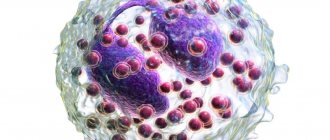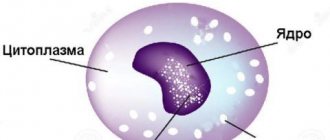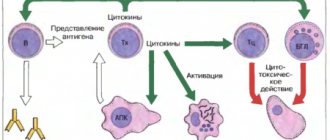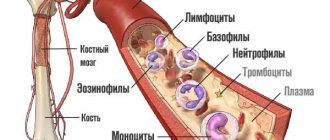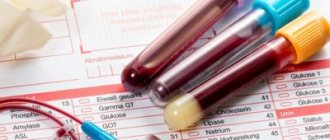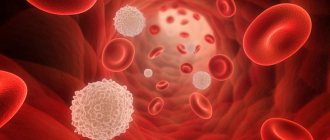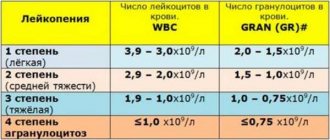In childhood, very often the immune system does not cope with its task, so the child gets sick and easily becomes infected with infectious diseases. In acute inflammatory processes, according to the results of the CBC, neutrophils may be decreased or increased.
Why do leukocyte blood type tests be carried out? Why do doctors look at neutrophil cell counts in children? Let's try to figure it out.
What kind of cells are neutrophils?
Neutrophilic leukocytes or neutrophils are the most numerous type of white blood cells.
They are formed in the bone marrow, where they undergo a series of stages during maturation. A myeloblast is formed from a precursor cell. The next cell is the promyelocyte. From it a myelocyte is formed, and then a metamyelocyte. These neutrophils are called juveniles. From them, rod forms mature. Further, mature cells – segmented neutrophils – are formed from them.
All types of neutrophil leukocytes differ from each other at different stages: the shape of the nucleus, the presence of granules. For example, segmented neutrophils contain a nucleus divided into segments.
The granules contained in the cytoplasm of neutrophils provide their ability to perform their biological functions.
The presence of granules in the cytoplasm of neutrophils allows them to be classified as granulocytic leukocytes. In addition to neutrophils, they also include eosinophils and basophils.
The main task of these cells is to fight foreign agents that enter our body. Therefore, there is a relationship between the content of these leukocytes and the presence of an infectious process.
Photo: https://moyakrov.info/blood/prichiny-povysheniya-ili-ponizheniya-segmentoyadernyh-nejtrofilov
How do neutrophils appear?
To suspect any pathology based on analysis, you need to know how cells are formed. This will help identify changes in indicators that should not be normal and assess how dangerous they are.
All neutrophils go through several stages of development before they take on their final form and begin to perform their functions. For convenience, we highlight the 3 most important stages of their maturation:
- Myelocytes and myeloblasts. This is the first stage of maturation, which occurs in the red bone marrow - a special hematopoietic organ located inside the human bones. It is extremely important that there are no leukocyte precursors in the blood. What their appearance may indicate and how dangerous this sign is, we will discuss a little later;
- Juvenile forms and band neutrophils. After the myelocyte matures, it enters the bloodstream and a new stage of its life begins. Circulating throughout the body, its maturation continues - the nucleus is divided into several parts, and granules with antimicrobial substances appear inside the cell;
- Segmented neutrophil is the last stage of formation. Its structure is adapted specifically to repel attacks from microorganisms and destroy/delimit dead tissue. The average lifespan is just over a week, which allows the body to regularly renew the pool of this blood component.
What do elevated neutrophils of each of these classes indicate? Almost always, this indicates the presence of some disease, as well as their deficiency. To understand what disease is hidden behind the change in the analysis, it is necessary to evaluate the value of each indicator.
Norms for neutrophil levels in children
The normal content of neutrophils in children is presented in Table 1. There are two main types of neutrophil leukocytes: band and segmented. Also, the units of measurement of a given type of cell will be presented in the form of relative and absolute values.
Absolute values show the content of a given cell type in the blood, expressed as 10 * 9 per liter. Relative numbers show how many cells of a given type were detected out of 100. Then the unit of measurement will be percentages.
Table 1. Norm of neutrophils in children.
| Age group | Absolute values | Relative values | |
| Rod | Segmented | ||
| Less than one year | 1.5 – 8.5 * 10*9/liter | 0,5 – 4 % | 15 – 45 % |
| One year – six years | 1.5 – 8.5 * 10*9/liter | 0,5 – 5 % | 25 – 60 % |
| From seven to twelve years | 1.8 – 8 * 10*9/liter | 0,5 – 5 % | 35 – 65 % |
| Over thirteen years old | 1.8 – 7.7 * 10*9/liter | 0,5 – 6 % | 47 – 72 % |
External signs of a decrease in neutrophils
Clinical manifestations of decreased neutrophils in a child’s blood depend on what factor triggered the decrease. Neutropenia in childhood can manifest itself:
- weakness;
- sweating;
- intestinal disorders;
- frequent colds;
- skin rashes (pustular or ulcerative);
- poor wound healing;
- stomatitis.
We recommend: Norms and causes of increased monocytes in children
Deviations from the norm are asymptomatic only with benign neuropenia in infants.
Moms and dads should be vigilant if their children are sick for a long time or their wounds are not healing well. Neutropenia does not go away on its own, and with a prolonged decrease in immunity, life-threatening conditions can develop.
Why are neutrophils low in a child?
The majority of neutrophils are segmented. Therefore, the reasons that segmented cells are reduced may be:
- disruption of the formation of neutrophil leukocytes in the bone marrow , for example, as a result of a malignant process;
- rapid death of neutrophils after performing their function - destroying the infectious agent. That is, with an excess of pathogenic agents, the body does not have time to produce new cells, their content decreases;
- a change in the number of other types of white blood cells , resulting in a change in the relative importance of the cells. Therefore, in this case it is better to take into account the absolute values of cells in the blood.
A decrease in the number of neutrophil leukocytes is called neutropenia.
Thus, the presence of some infectious diseases is accompanied by the fact that segmented neutrophils are reduced in children. Examples of such diseases may be:
- rubella;
- hepatitis;
- chickenpox;
- flu;
- fungal infection and others.
Photo: https://pixabay.com/photos/cold-headaches-health-influence-3861935/
Forms of neutropenia: how do they occur?
A decrease in neutrophils in most cases is not associated with genetic factors, which are very difficult to treat and are an independent disease. As a rule, they are caused by some kind of infectious invasion, dysfunction of the liver/kidneys, thyroid gland and bone marrow. That is why for diagnosis it is very important to establish the exact cause of the development of abnormalities in the blood.
Neutropenia occurs in three forms:
- Easy. It may not cause any symptoms or be accompanied by frequent colds, local bacterial damage (for example, skin pustules that are difficult to eliminate).
- Average . Recurrent purulent inflammations and infections are noted. The patient has damage to the mucous membranes of the mouth (gingivitis, stomatitis).
- Heavy . Accompanied by severe intoxication with resulting symptoms. Mucous tissues can become inflamed, suppurate, and die in small areas. In children, the temperature rises, fever develops, and purulent infections often occur.
There is no point in relieving the symptoms of disorders, because a lack of leukocytes cannot be treated as an independent disease. It is imperative to direct all actions to eliminate the root cause of the decrease in immune strength. If it is an infection, it means destroying the pathogen. And when deviations are caused by impaired functionality of internal organs, then treatment of a specific disease should be undertaken.
When children are referred for testing
Determining the level of neutrophils in the blood is included in such an indicator as the leukocyte formula. It involves counting the types of leukocytes. The calculation of the leukocyte formula is most often included in the CBC (general clinical blood test).
The purpose of this blood test is to:
- assess the child’s condition in the absence of any complaints during a routine examination;
- identify the presence of an infectious process if it is suspected, especially when there are clinical manifestations;
- identify disorders of blood cell content as a result of a hereditary disorder or tumor process.
That is, the CBC is a simple but quite informative blood test, which is prescribed for preventive purposes, as well as for any disease.
Sometimes a decline is preceded by a rise
When neutrophils are elevated in a child, this means that the immune system responds with increased cell production to the effects of unfavorable factors. Neutrocytosis can be caused by:
- infections (fungal, bacterial or viral);
- non-infectious inflammations (arthritis, SLE, appendicitis);
- poisoning;
- large burns;
- blood loss;
- trophic ulcers;
- hemolytic anemia;
- oncology;
- postoperative period.
We recommend: The main causes of increased red blood cells in a child
If neutrophils are increased in a child and blood sugar is elevated, then diabetes may be the cause.
Long-term exposure to unfavorable factors leads to the fact that the immune system is gradually depleted, cell production decreases and the increased neutrophil count is greatly reduced.
Preparing for analysis
In order to find out the number of neutrophil leukocytes, you need to donate blood from a finger or from a vein. This biological material must be taken on an empty stomach in children over five years of age. It is recommended not to feed infants for 30 minutes before blood sampling, and for children under five years old - for 3 to 4 hours.
It is also desirable that the patient does not experience emotional overload. Parents should motivate their child to withstand the “finger prick” and explain that there is nothing wrong with it.
Parents should also make sure that the child does not run around the hospital corridors before the blood is drawn.
The baby's hands should be warm. If they are cold, blood will flow poorly from the finger, causing discomfort to the medical staff and the child.
Photo: https://pixabay.com/photos/nurse-diabetes-diabetic-test-a1c-527615/
Method for determining the level of neutrophils in the blood
Most analyzes in a modern laboratory are performed by analyzers. Determination of the number of neutrophils can be done on an automatic hematology analyzer.
Another option for determining the number of neutrophil leukocytes is the manual method of calculating the leukocyte formula. A blood smear is made and stained with special dyes that allow different types of white blood cells to be identified among each other.
The microscope is then used to count 100 cells per field of view, noting which cells are seen. Then the relative value of each leukocyte found in the smear is indicated.
In a blood smear you can see different degrees of maturity of neutrophils, as well as basophils, eosinophils, lymphocytes, monocytes, and morphological features of red blood cells (size and shape).
In the presence of which diseases is an increase in neutrophils observed?
If the baby is more than one year old, and the level of band and segmental neutrophils is significantly higher than normal, then this indicates a problem in the body.
An increase in the number of leukocytes can be affected by intense physical activity, as well as severe stress. It is worth noting that in this case the deviation from normal indicators is insignificant.
A patient is diagnosed with neutrophilia if the excess is more than 6.5 billion per liter of blood. Such an increase may be caused by:
- Trophic ulcers that do not heal for more than six weeks;
- Leukemia;
- Burns of the 3rd and fourth degree;
- Increased breakdown of red blood cells and a decrease in their life expectancy;
- Diseases occurring in acute form: tonsillitis, inflammation of the middle ear, lungs, peritoneum;
- With general infection of the cut.
These are the main reasons why lymphocytes are elevated. The intensity of the development of the inflammatory process directly affects the number of blood cells, i.e. the stronger the inflammation, the more neutrophils. In such cases, you should immediately contact a medical facility.
Data. If it were possible to get all the leukocytes from the human body and arrange them all in one chain, then its length would be more than five hundred km.
Analysis transcript
Interpretation of the study results should only be carried out by a doctor. He will take into account all the nuances:
- what is the child’s condition at the time of treatment;
- are there any complaints;
- data from other blood or urine tests;
- child examination data;
- heredity.
In laboratory practice, high and low neutrophil values occur. It has already been indicated above what reasons may contribute to a low level of neutrophils in the blood.
A high level of neutrophils indicates that at this moment the body is fighting an infection. All the “fighters” went to fight the pathogenic agent. And this condition is called neutrophilosis.
Causes of neutropenia
- Most often, deviations in tests from the norm are caused by benign neutropenia. This condition does not pose a danger to the baby and goes away on its own over time. As a rule, no treatment is prescribed. Please note that this condition is not a contraindication to routine vaccination.
- Sometimes a decrease in the number of these cells is the result of taking antibiotics, antipyretic drugs (analgin and its derivatives), which are used to combat cancer or after transplantation.
- If neutropenia is caused by blood diseases, such as leukemia, you should definitely consult a hematologist.
- This condition is also caused by radiation, poisoning with various poisons, including mercury vapor.

